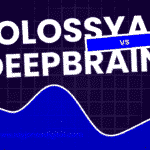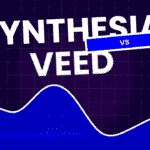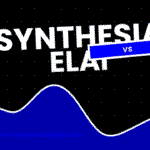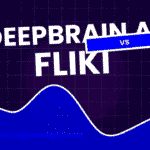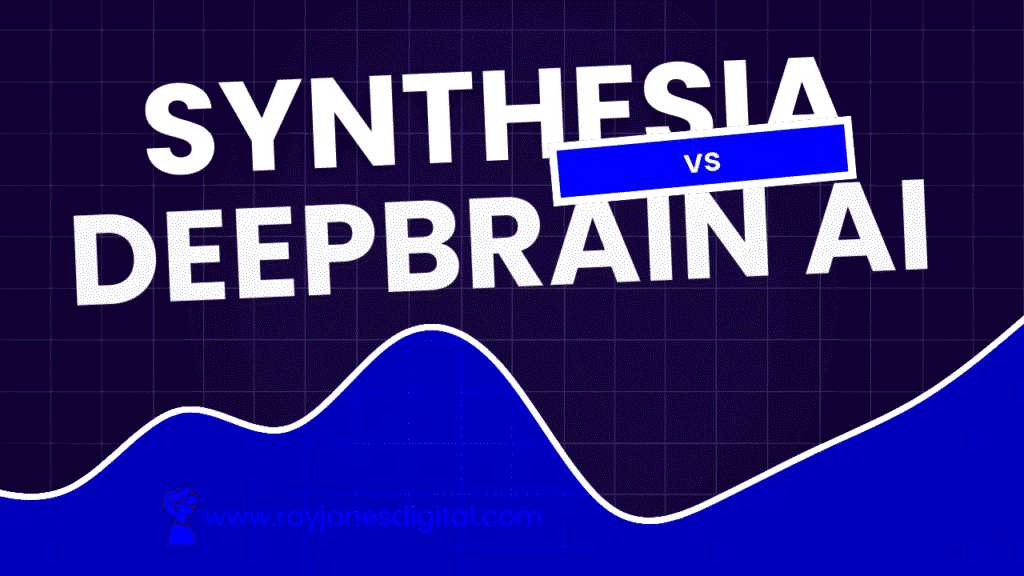
Are you tired of spending hours and piles of cash on creating high-quality videos? With AI video generation, crafting professional content has never been easier or more cost-effective. Two heavyweights in this game, Synthesia vs DeepBrain AI, are turning heads in industries from marketing to education. But when it comes to picking the right tool for your needs, things can get tricky. Both offer unique features, but their differences could make one a better fit for you over the other. Ready to simplify your video creation process? We’ll dive into both platforms, highlight what sets them apart, and help you make an informed choice. Let’s get started!
Introduction to AI Video Generation
AI is changing how we make videos. Picture this: professional videos created without cameras or crews. It’s a game-changer for industries like marketing, education, and more.
The Rise of AI in Video Production
AI video generators are gaining popularity fast. They help create content quickly and cheaply. Why hire actors when you can use a lifelike avatar? According to [Fahimai](https://www.fahimai.com/synthesia-vs-deepbrain), AI tools are transforming video production by eliminating long shooting processes.
Applications of AI Video Generators
You can use AI videos for many purposes. Want to spice up your marketing campaign? AI tools are perfect. Need to train employees worldwide? Create training videos without language barriers. AI platforms, like DeepBrain and Synthesia, support multiple languages, making them ideal for global audiences.
Key Players in the Market
Two major names dominate AI video generation: Synthesia and DeepBrain AI. Synthesia offers diverse avatars and supports over 100 languages. It’s excellent for training materials and marketing content. DeepBrain, on the other hand, shines with customizable avatars and quick video turnaround. Jobs that took days can now be done in hours with these tools.
With so many options, the question is, which will suit your needs best? Stay tuned to learn more!
Synthesia Overview
Synthesia is a leading AI video generation platform. It helps you create videos without cameras or costly production. Let’s dig into its standout features and what makes it unique.
Core Technologies and Features
Synthesia is powered by advanced AI and machine learning. These tools let you create lifelike AI avatars. You simply type your script, pick an avatar, and get a polished video. Need an avatar that speaks in different tongues? Synthesia supports over 120 languages, perfect for global audiences. The platform also includes screen recording integration. This feature allows you to seamlessly add screen recordings to your AI videos, ideal for walkthroughs or tutorials.
Supported Video Formats and Resolutions
Video format flexibility is crucial, right? Synthesia delivers here too. You can produce videos in Full HD with resolutions like 1920×1080 (landscape) and 1080×1920 (portrait). These outputs are perfect for anything from social media content to business presentations. Plus, the video quality remains impressive, maintaining sharp visuals and smooth animation.
Use Cases and Industry Applications
Synthesia suits various industries, solving real-world problems. For example, companies use it for training videos. You can create multilingual training content without needing multiple teams. Marketing teams love Synthesia for personalized video messages. You can connect better with customers in their own language, using avatars that look professional and engaging.
By catering to different industries and needs, Synthesia stands out as a versatile and powerful video creation tool, helping businesses save time and money.
DeepBrain AI Overview
Let’s explore DeepBrain AI, a key player in the AI video scene. It’s known for its unique strengths and features.
Technology Behind DeepBrain AI
DeepBrain AI uses advanced neural networks. What’s special? It creates realistic avatars with lifelike expressions. These AI tools make video content engaging and relatable. DeepBrain AI supports over 80 languages. This is perfect if you’re reaching a global audience. It also offers quick video production. You can go from script to video in a few hours.
Key Features and Capabilities
DeepBrain AI is big on customization. Want an avatar that matches your brand? You can tweak facial features, clothing, and more. This lets your videos stand out. It also includes text-to-speech with natural-sounding voices. Need editing tools? They come built-in, making video adjustments easy. Integration with ChatGPT means scripting is a breeze. Imagine writing scripts almost on autopilot.
Examples of Successful Implementations
DeepBrain AI shines in business settings. Picture GlobalTech Corp needing training videos for teams worldwide. They used DeepBrain AI to produce videos in dozens of languages. This saved them weeks of production time. Or consider startups wanting lively product demos. With customizable avatars, they achieve just that, engaging audiences like never before.
In short, DeepBrain AI offers versatility, speed, and customization, making it a great choice for businesses and creators alike.
Key Differences Between Synthesia and DeepBrain AI
So, you’re trying to choose between Synthesia and DeepBrain AI, right? They’re both awesome for video generation, but they have their differences. Let’s break down how they compare in pricing, user experience, and customization.
Comparison of Pricing Models
Pricing can be a big factor. Synthesia starts at around $22/month for basic features. It’s a bit more budget-friendly for small-scale projects. They also offer custom pricing for enterprise needs if you’re looking for more minutes and features.
DeepBrain AI, on the other hand, begins at $29/month. It’s slightly more expensive but comes with different tier options depending on your needs. If you go enterprise, expect custom pricing here too. You’ll pick based on what matches your budget and project scope.
User Interface and Experience
Both tools are designed with ease of use in mind, but they cater to different users. Synthesia packs a feature-rich interface—great for those who need more control over their videos. You’ll love it if you’re a power user who likes detailed features.
DeepBrain AI keeps it simple. Its streamlined studio is perfect if you want to produce videos quickly without much fuss. If you’re new to AI video tools or want a more straightforward experience, DeepBrain might be your go-to.
Customization and Flexibility
Do you like customizing your avatars? Synthesia offers a vast range of 140+ avatars with a twist of diversity. It’s superb for creating videos that need a universal appeal with animated avatars.
In contrast, DeepBrain AI shines in customization. You can tweak avatar appearance extensively. Want a video where the avatar perfectly matches your brand’s vibe? DeepBrain’s customization options allow more hands-on control to make unique, branded videos.
Both platforms deliver HD quality but lack 4K support. If template variety is your thing, DeepBrain offers 500+ templates, outpacing Synthesia’s 55+.
Choosing What’s Best for You
To wrap it all up: if you need a broader language range and a powerful feature set, Synthesia is great. But if customization and quick video creation are crucial, DeepBrain AI might win you over. Consider what suits your use case and budget best!
Performance and Output Quality
Understanding how Synthesia and DeepBrain AI stack up in terms of performance is crucial. So, let’s dive into their resolution, realism, and audio synchronization.
Resolution and Quality Assessment
Both Synthesia and DeepBrain AI offer Full HD video output. This means videos look sharp and fit well for professional use. Synthesia provides video in both landscape (1920×1080) and portrait (1080×1920) format. This flexibility makes it great for social media and business presentations.
DeepBrain AI also supports Full HD resolution, ensuring your visuals remain crisp and clear. Whether for explainer videos or corporate presentations, you get a polished result. For instance, creating training videos with either tool provides users high-quality visuals that maintain audience engagement.
Realism in AI-Generated Videos
When it comes to realism, Synthesia leans towards diverse avatars that can fit many scenarios. Is your training program global? Its 140+ avatar options, featuring different ethnicities and styles, make your content more relatable and inclusive.
DeepBrain AI, however, focuses on human-like avatars with smooth facial expressions. Is your goal to convey professionalism with a hint of personalized touch? You might find DeepBrain’s avatars ideal for this task. They shine especially in business settings where believable human interaction is key.
Audio and Lip-Sync Performance
Audio syncing can make or break a video. Synthesia does a fantastic job with multilingual support, offering over 120 languages. The lip-sync is quite precise, which is vital when delivering content in multiple languages. This ensures your audience gets a seamless viewing experience without awkward delays or mismatched voices.
DeepBrain AI isn’t far behind, supporting over 80 languages with natural-sounding voices. Its emphasis on voice quality and lip-sync accuracy makes it a strong contender, especially if your target audience is global. Imagine your corporate training sessions reaching teams worldwide without a hitch.
Both platforms excel in output quality, but your choice boils down to specific needs. Whether it’s diverse language support or realistic avatars, both have you covered for creating stunning, professional videos.
User Testimonials and Case Studies
Let’s dive into real experiences with Synthesia and DeepBrain AI. Get ready to see how these tools perform in the real world!
Customer Reviews for Synthesia
Synthesia users rave about its ease of use. Many find it perfect for creating training videos without needing video production skills. A marketing manager at TechCorp appreciates the platform’s multilingual support, saying, “It saves us time and lets us connect with global teams effectively.” According to [VentureBeat](https://venturebeat.com/ai/synthesia-announces-platform-update-with-interactive-ai-videos-full-body-avatars/), the recent addition of interactive AI videos has thrilled users, making content more engaging.
DeepBrain AI User Experiences
DeepBrain AI gets high marks for its natural-sounding avatars. Users in the corporate world love the quick turnaround time. A training director at GlobalTech stated, “We create high-quality training videos in hours, not days.” This efficiency has made DeepBrain a favorite for fast-paced environments. According to [Daily AI Hub](https://dailyaihub.com/deepbrain-ai-vs-synthesia-the-ultimate-ai-video-tool-review/), businesses value its customization options, which allow branding consistency across videos.
Case Studies Highlighting Real-World Solutions
Synthesia Case Study: An international company, GlobalEd, used Synthesia to streamline their employee onboarding. They crafted multilingual videos, reducing training time by 30%. Employees found the content engaging, attributing this to the lifelike avatars.
DeepBrain AI Case Study: A retail chain needed quick promotional videos across different regions. Using DeepBrain AI’s customizable avatars, they produced 20 unique adverts within a week. Marketing efforts saw a 25% boost in customer engagement.
Both tools deliver outstanding results, each with unique strengths. Which suits your needs better might depend on the specific context and goals of your project.
Future Prospects and Industry Impact
Alright, let’s explore what the future holds for Synthesia and DeepBrain AI. These tools could reshape industries like advertising and education with their emerging tech and potential challenges.
Predicted Technological Advancements
AI video tools like Synthesia and DeepBrain AI will likely boost realism and speed. Think smoother avatars and faster processing. For instance, imagine avatars that understand and react to emotions! This would make educational videos more engaging. DeepBrain already offers natural facial expressions. In a few years, avatars might have unique personalities. Plus, expect AI to handle more complex scripting, thanks to advancements like ChatGPT.
Impact on the Creative Industry
The creative industry could explode with possibilities. AI tools can lower production costs, letting small creators compete with big studios. For ads, think personalized commercials tailored to every viewer’s taste. Synthesia allows avatars to speak in over 120 languages, perfect for global brands. Educational content will become more interactive, too. Virtual teachers that adapt to student needs might be commonplace. No more boring lectures; imagine an AI tutor that knows just what you need.
Potential Challenges and Opportunities
Sure, AI video tools have challenges. Alignment of AI avatars with brand identity can be tricky. Customization limits might hinder some creators. However, these challenges create innovation opportunities. Companies might develop better avatar customization features. Plus, ethical concerns are also key. Who owns the content an AI generates? Getting regulations right will shape how these tools grow. If handled well, AI-generated content could become a staple across digital platforms.
The future seems packed with possibilities. As AI tech evolves, Synthesia and DeepBrain AI could redefine how you create and consume video content, making it more personal and efficient. Consider what that might mean for your future projects!
Choosing the Right Tool for Your Needs
Picking between Synthesia and DeepBrain AI isn’t easy. Each tool has its perks. Here’s how to choose based on your needs and budget.
Factors to Consider for Different Industries
Different industries have unique needs. For example, if you’re in education or corporate training, Synthesia might be your best choice. It offers over 120 languages, making it perfect for global lessons and tutorials. Plus, its avatars help make content engaging.
In contrast, if you’re in marketing and need quick, personalized videos, DeepBrain AI is worth checking. Its customizable avatars ensure your brand shines through every video. It’s ideal for creating product demos quickly, saving time and resources.
Cost-Benefit Analysis
Budget is crucial, right? Let’s talk numbers. Synthesia starts at $22/month, offering 120 minutes of content annually. That’s great for small projects or periodic video needs. On the other hand, DeepBrain AI’s basic plan starts at $29/month. It provides more flexibility with package options depending on your needs.
If you’re in a corporate setting or need unlimited features, expect custom pricing from both. Weigh their costs against what you’re creating. Do you need lots of languages? Choose Synthesia. Is customization key? Go with DeepBrain AI.
Final Recommendations
Now, which should you choose? If global reach and diverse languages matter most, go with Synthesia. Its ease of use and feature set fit educational and corporate settings perfectly.
But if personalization and quick video turnaround are your top priorities, DeepBrain AI might be better. It’s great for marketing teams seeking branded content fast.
Conclusion: Assess your project needs carefully. Consider your industry requirements and budget. The right choice depends on what you value most in a video tool.
Let’s wrap things up and make the final call on Synthesia vs DeepBrain AI: we’ve seen how these two potent AI video generation tools redefine how you create videos. Despite their differences—Synthesia excels with diverse avatars and language options, while DeepBrain AI offers deep customization and natural avatars—both stand as titans in video innovation. Remember, Synthesia suits you if global reach and powerful features are priorities. However, if you’re tight on time and crave personalization, DeepBrain might just be your perfect match.
Your next step is simple: evaluate what means more to you—broad language support with Synthesia or quick, personalized video creation via DeepBrain AI. Whichever path you choose, both hold the key to efficient, top-tier content creation.
So, take the plunge and revolutionize how you create videos. Which will it be—Synthesia or DeepBrain AI? The choice is yours but make it today and transform your video production journey!
Frequently Asked Questions
Can you create AI videos in multiple languages with Synthesia and DeepBrain AI?
Yes, both Synthesia and DeepBrain AI support multiple languages for AI video creation. Synthesia offers support for over 120 languages, which is great for global communication. DeepBrain AI also provides multilingual capabilities, supporting over 80 languages. This feature helps businesses and creators connect with international audiences effectively.
How do Synthesia and DeepBrain AI differ in terms of avatar customization?
Synthesia offers a wide range of over 140 avatars with diverse appearances that fit various scenarios. However, DeepBrain AI allows deeper customization, letting you adjust features such as facial expressions and attire to create avatars that align closely with your brand. This makes DeepBrain AI suitable for companies looking to maintain a strong brand identity in their videos.
Do Synthesia and DeepBrain AI provide free trials?
Yes, both Synthesia and DeepBrain AI offer free trials to new users. Synthesia provides limited features for first-time users to explore, while DeepBrain AI offers a free 1-minute video trial. This allows potential users to test out the platforms and see which one meets their needs before committing to a subscription.
Is it easy to use Synthesia and DeepBrain AI for beginners?
Both platforms are designed to be user-friendly, but each caters to different user types. Synthesia’s interface is feature-rich, which might take some time to learn but offers more control for advanced users. In contrast, DeepBrain AI has a more streamlined, intuitive interface, making it easier for beginners or those who need to create videos quickly without a steep learning curve.
What kind of businesses benefit the most from using Synthesia or DeepBrain AI?
Synthesia is ideal for educational content, training, and marketing purposes due to its extensive language support and range of avatars. DeepBrain AI is better suited for businesses in need of quick, customizable videos, such as for internal communications or branded promotional content. Companies focused on speed and personalization might find DeepBrain AI to be more in line with their needs.
Do these tools support 4K video resolution?
Currently, both Synthesia and DeepBrain AI offer video outputs in Full HD resolution, but they do not support 4K video resolution. This should be sufficient for most use cases like social media uploads, corporate presentations, and online course content.
What factors should you consider when choosing between Synthesia and DeepBrain AI?
When deciding between the two tools, consider your specific needs such as language support, budget, avatar customization, and user interface preference. Synthesia is more suitable for those needing a wide language range and diverse avatar options, while DeepBrain AI is ideal if personalization and ease of use are top priorities. Assess how each platform’s features align with your project requirements and industry standards.

I am Ray Jones Digital
My current occupations: a Digital Marketer, Local SEO expert, Link Builder, and WordPress SEO specialist. Shopify SEO, Ecommerce Store Management, and HTML & WordPress Developer I have been practicing the above mentioned services for more than 10 years now As an SEO expert working with your ongoing projects.
